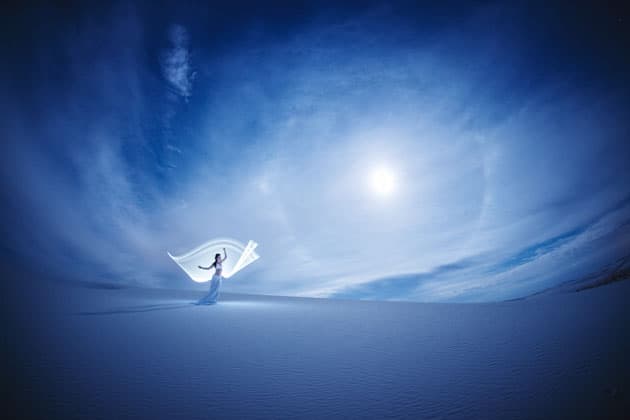What is light painting?
Light painting – simply put, moving a light source during a long exposure – is often considered something of a dark art. But it doesn’t have to be that way. Some of the most celebrated artists in the genre began with little more than a DSLR, a torch and a general sense of playfulness.
As light painters perfect their art, they often choose to specialise: some like to illuminate a subject or a carefully chosen space, others prefer to ‘write’ with a light source, forming bold, colourful letters or shapes. A few of these set-ups require multiple cameras and teams of assistants, but most start with a simple light source – usually in the form of a torch, acrylic rod, strings or strips of LEDs, plastic tubes, fibre optic brushes or steel wool – a DSLR, a remote shutter release, a tripod, and a willingness to experiment. (Please note: there are dangers involved in using steel wool, so the utmost care must be taken if you decide to use this material.)
Many of the light-painting artists featured here have posted a lot of advice about their techniques and approaches; so check out the social media details at the end of each of their respective biographies.
Eric Paré’ light painting tips

Credit: Eric Paré
Light painting allows you to break out of more traditional approaches to photography – suddenly you are with the subject, instead of watching from behind the camera. There is something healthy and creative about the whole process, and that is what keeps me at it, pushing myself over and over again. Also, because each picture is lit by hand, every photograph is totally unique, which really appeals to me as an image maker.
Move beyond the basics
We all know the basics of light painting: mount your camera on a tripod, select bulb mode, and use a light source to paint in front of your subject. However, if you want to get more creative and use tube lighting, you need a bright torch (about 1,000 lumens), a plastic tube, and some creativity. Armed with all of this you can start ‘drawing’ shapes behind your subject.
Make yourself invisible
To make a perfect circle, start and stop behind one of your subject’s legs (to avoid any overlay). Keep your exposure within three seconds, and within that time ask your subject to be completely still. By keeping good alignment behind your model, you will make yourself completely invisible. Trust me, it’s easier than it looks!
Eric Paré is a Canadian photographer whose work mostly involves light painting and multi-camera installations. Eric travels the world, sometimes with hundreds of cameras and sometimes with a single light-painting tube. See Instagram: @ericparephoto and kimhenry.dance; YouTube: ericpare; Website: ericpare.com.
Daniel González García’s light painting tips
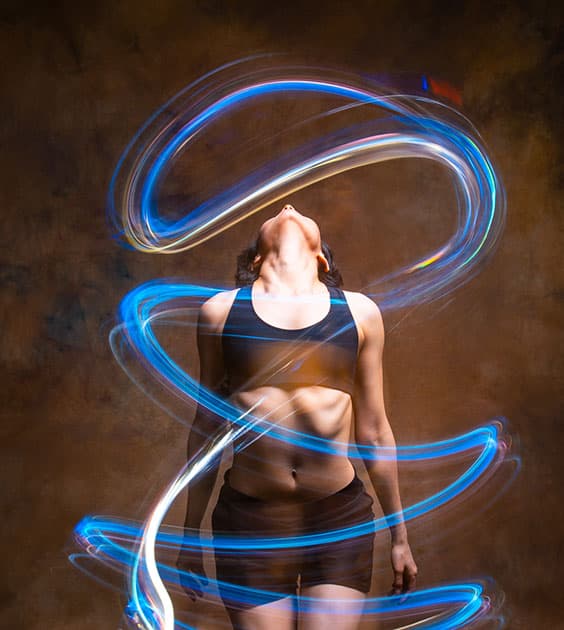
Nikon D750, 38mm, 13sec at f/13, ISO 100. Credit: Daniel González García
Light painting allows you to be very creative, and it helps you to break out of the conventional way of doing things. I see it as a kind of game; playing with lights in the dark. When I’m creating a portrait I like to think about all of the possibilities available to me. You can create many different environments, and you learn a lot about lighting! I really enjoy that brief moment just before you see the picture. It can be a pleasant surprise.
Dim the lights
Mount your camera to a tripod, and make sure the room is dark. If it helps, you can keep a very dim lamp on to see, without it affecting the exposure.
Mix different light sources
Experiment with combinations of continuous light, flash and, of course, the light from a torch (200 lumens works for me, but you might decide you need something brighter). You can also use colour gels.
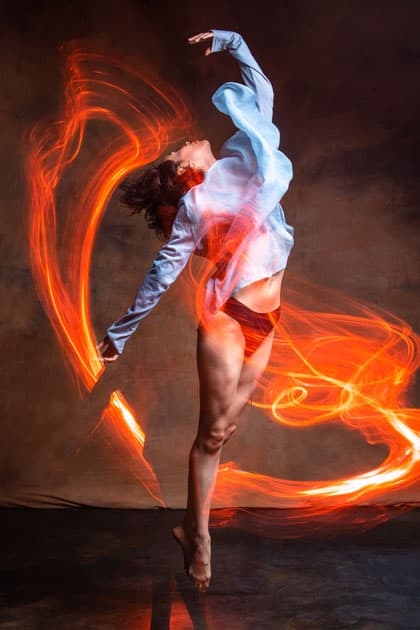
Nikon D750, 38mm, 15sec at f/13, ISO 100. Credit: Daniel González García
Experiment with flash
Set your camera to rear-curtain sync and use a long exposure so you can paint before the burst of flash comes. Try 5sec, 10sec, 20sec, and so on.
Make your own light painting tools
Take an empty soda bottle and fill it with cellophane, then attach your torch to the bottleneck. Alternatively, use a roll of baking paper attached to a torch – now you have your own lightsaber.
From Mexico, Daniel González García has always had a passion for self-expression through the arts. He is currently working on a dance portrait project entitled Dancing Lights – the images here feature ballerina Patricia Amezcua. To see more of his work visit Instagram: @dgzzfoto.
Dennis Wolff’s light painting tips

Canon EOS 77D, 10-18mm, 210-250sec at f/10, ISO 200/100. Credit: Dennis Wolff
For me, light painting is a way of using photography to capture certain moods, events, objects and people. I love the handicraft element too. It helps to be interested in artistic design because you need to balance colour and light in a way that conveys a mood successfully. Once you have perfected your light-painting tools, and a location has been decided on, the process of creative realisation can begin.
Know your tools
I started out with a Canon EOS 1000D, and later switched to an EOS 77D. You will need to invest in powerful torches (1,000-2,000 lumen) for illuminating wider surroundings, and creating shadows. I also use medium torches (500-1,000 lumen), and a stroboscope. Small torches are handy for ‘writing’ with light and illuminating people. Pool lamps are good for lighting rooms and objects with colour, and a headlamp or construction lamp can be useful.
Wait for a full moon
A full moon creates the most beautiful compositions and shadows during a full moon. If the moon is hidden behind a tree, a building or similar, special pictures can be created, where the surroundings do not require additional lighting.
Turn on the pool lights
RGB pool luminaires are great for providing soft background lighting or adding colour to objects, individual areas or entire rooms. They are dimmable and, depending on the model, the colours can often be adjusted.
Twist the tubes
You can achieve a lovely effect by twisting two tubes with different lighting together. One tube can be operated in stroboscopic mode, while the other stays in continuous mode. Both tubes have the same centre of rotation – to make this easier you can secure the tubes with clamps. They are then turned lying next to each other so that no pipe covers the other.
Dennis Wolff lives in Lüneburg Heath in Lower Saxony, Germany, with his family, a dog and a cat. When he’s not working as an auditor and supplier developer he enjoys spending time with his family, running, being out in nature and light painting. See Instagram: @1607nightshift.
Katrina Brown’s light painting tips
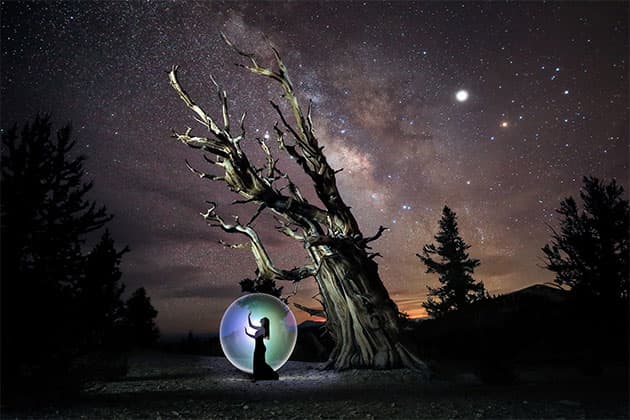
Canon EOS 5D Mark IV, 16-35mm, 20sec at f/2.8, ISO 8000. Credit: Katrina Brown
Light painting allows me to make something permanent out of something temporary. It is creating a piece of art, only you can’t see it as it’s being made – this uncertainty is very exciting to me. I like to create scenes that tell stories, triggering thoughts and emotions. My pictures involve multiple elements and techniques. This type of photography is unpredictable, and happy accidents are a big thrill when they happen.
Don’t use just one light
Use a variety of tools, light modifications and colours to ‘paint’ the scene. Think as though you are creating a painting. In the dark, your camera is like a black piece of paper, so take your time to paint well.
Think before you act
Before you start creating your image think about what you want to convey – it might be an emotion, a mood or a statement. With that in mind, think about which colours will convey your message. Next, consider if you need a model or not. With the big decisions made, set the scene and try to recreate what you saw in your mind’s eye.
Kit yourself out
Many light-painting tools can be handmade, but one essential purchase is a dimmable torch that is small enough to fit into tubes or pipe fittings. I prefer tactical torches that have pressure switch triggers, making it easy to turn them on and off. Homemade tools can be made using fluorescent tube guards, with gels added for colour. Soda bottles, plastic pool toys, pretty much anything with colour and the space to fit a torch inside it can become a light painting tool! See my website for more about the gear I use.

Canon EOS 5D Mark IV, 24-70mm, 77.3sec at f/13, ISO 250. Credit: Katrina Brown
Consider your positioning
Don’t stand next to the camera and paint the scene from this viewpoint – much like onboard flash, the results will appear flat. Instead, move to one side of the camera, or even way behind it, to shape and create varying degrees of depth in the picture.
Perfect your exposures
Remember that the best metering system is your eye. Expose the scene for the ambient light and then build the shot by testing your light sources. The brighter the ambient light, the more lumens the torch needs. You can only control your light, not the ambient light around you, so that’s the variable you change when building up the scene. If you really don’t know where to start, begin at ISO 100, f/8, with a 1,000 lumen light source and then take it from there.
Plan ahead
Make a list, a storyboard; whatever helps you think through your ideas ahead of time. This way your success rate will be much higher and you will carry less gear to your location. Also, plan to wear as much black clothing as possible to avoid being seen in the pictures.
Katrina Brown has been a commercial photographer since 1994 and is passionate about night photography. She loves experimenting with points of light, the Milky Way and light painting. To see more of her work visit Instagram: @redheadkatrina; Website: www.lightpaintedart.com.
Andrea Riezzo’s light painting tips
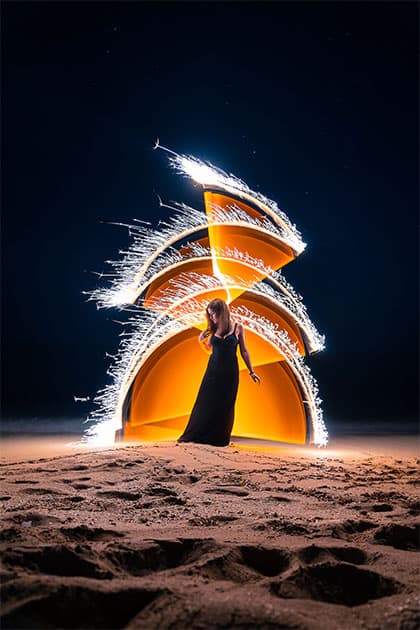
Sony Alpha 7 III, 24mm, 4sec at f/4, ISO 400. Credit: Andrea Riezzo
What I love about light painting is the ‘wow’ factor a picture can have. Sometimes it feels as though you are a magician. With a light source, and some carefully considered movements, you can create something unique. But there must be context, a story or a sense of place. For that reason, I don’t like abstract light painting, using too many colours or, worse still, creating too many shapes. For me, less is more. I have been inspired by Eric Paré, but over the years I have developed my own style, correcting my mistakes as I go along. It’s not easy to coordinate breath, movements, equipment and a model in one shot, but it is possible!
Select your subject with care
This is crucial. Choose materials that allow light to bounce off them properly so you can light a subject or surroundings properly – human skin and stone are two good examples.
Light the subject
Use your light painting tools to light your subject, not the background. When you are ‘drawing’ a shape, try to move the light source in a way that creates contrast between these two elements.
Stay focused
There are plenty of elements to consider when you are light painting, so keep your mind on the job and try not to get distracted.
Stay local
When you’re looking for a location for a light painting shoot, start with your local area. I’m lucky in that I live in a beautiful region of Italy with clear skies and peaceful shores on my doorstep, but use your imagination.
Make connections
Go to any hardware store (or search online) and you will find plenty of translucent materials that can be connected, in some way, to a torch. Your set-up might look ugly, but who cares – light painters work in the dark so no one needs to see your DIY handiwork!
Andrea Riezzo lives in the city of Lecce, Apulia, Italy. He collaborates with various artists and uses photography (and light painting) to provide unique experiences to tourists visiting Apulia. To see more of his work visit Instagram: @sublument and @andriezzo; Website: www.sublument.com.
Rod Evans’ light painting tips
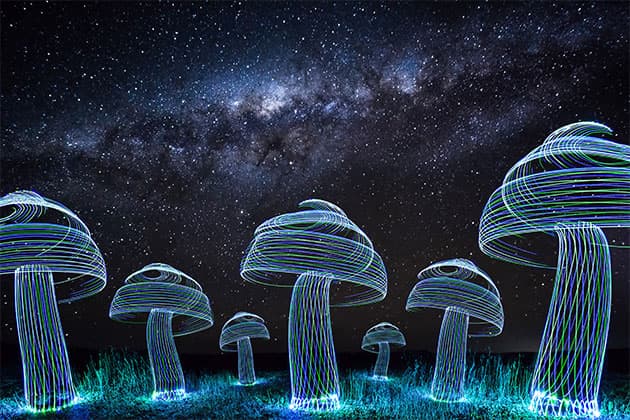
Photoshop composite: Canon EOS 650D, 10mm, f/4.5. Stars: 30sec, ISO 3200. Mushrooms: 15sec, ISO 100. Credit: Rod Evans
Light painting, for me, is a form of meditation; it keeps me in the moment and allows me to momentarily put my worries aside. It also forces me to get out and explore my surroundings. I have found so many amazing locations due to my drive to create interesting light painting compositions. The style of painting I prefer – or that I’m most known for – is hand-drawn orbs using acrylic rods or tubes. The main thing I love about light painting is saying ‘wow’ when I see what I have captured.
Think outside the box
When you go into a store and see plastic items, try to see them for their colour and shape and imagine what they would look like if they had light shining through them. Most of my light painting tools are made out of items I have found in dollar stores or found lying around. I very rarely buy purpose-built light painting tools.
Keep a sketchbook
When I head out on a shoot, I always take more tools than I need. When I get to the location I use about two or three of them for the pictures, and then pack up my gear and head home. But when I get home a previously conceived idea pops into my head and I think, ‘Why didn’t I do that while I was there?’ This has happened on numerous occasions, so now I have a book for writing down my thoughts and sketching designs and shapes, which I take with me.
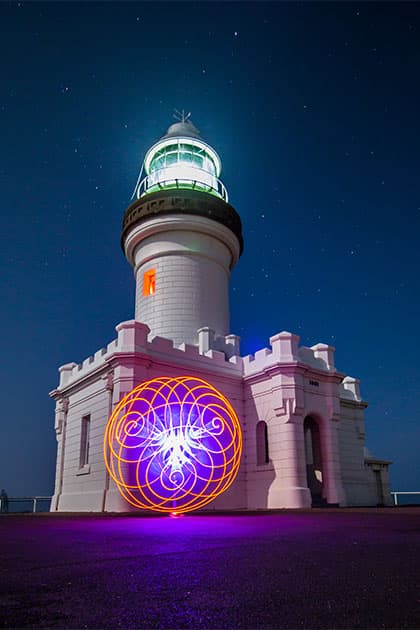
Canon EOS 650D, 12mm, 37sec at f/5, ISO 200. Credit: Rod Evans
Take heat packs
When I’m shooting long exposures in the cold, my lens can start to fog up due to the heat from the camera body. As a result, I am constantly using a lens- cleaning cloth to wipe off the moisture. To combat this, I attach heat packs for hands under my lens.
Use a remote shutter release
For the first few of years of my light-painting adventures, I set the timer to 10 seconds and then ran to get into position before the shutter opened. At times this was awkward, because there were obstacles I had to navigate in the dark (granite boulders, deep watery crevices etc) so one day I invested in a remote-controlled shutter release for my DSLR, and I have never looked back. It allows me to open and close my shutter from a distance of up to 100m away, which saves me a lot of hassle when I’m out on location. I highly recommend this for anyone interested in light painting.
Rod Evans likes to explore and capture New South Wales via landscape, astro, 360, time-lapse and light painting photography. To see more of his work visit Instagram: @rod.evans.visual, YouTube: rod.evans.visual, Steemit: steemit.com/@rod.evans.visual and Red Bubble: redbubble.com/people/rodevans/shop.

